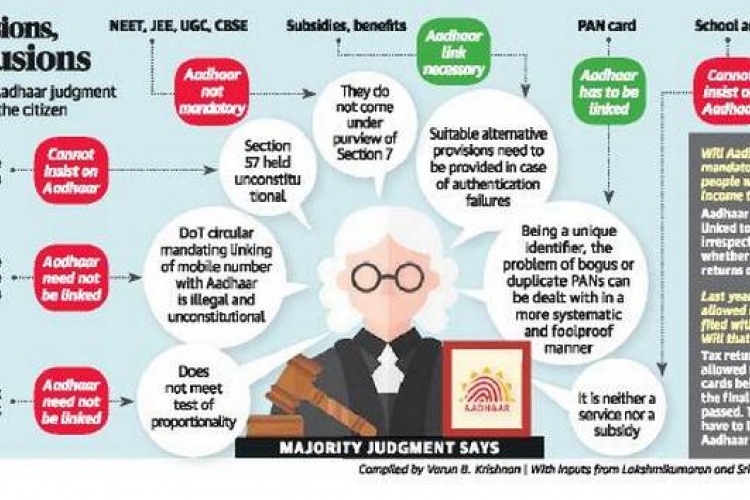AADHAR GETS THUMBS UP
IN NEWS
The Supreme Court upholds the passage of the Aadhaar Act as a Money Bill; says it fulfills government’s aim to provide dignity to marginalised.
THE VERDICT
The Supreme Court, in a majority opinion upheld Aadhaar as a reasonable restriction on individual privacy that fulfills the government’s “legitimate aim” to provide dignity to a large, marginalised population living in abject poverty.
“The Constitution does not exist for a few or minority of the people of India, but ‘We the People”
It read down Section 33 (1), which allowed the disclosure of Aadhaar information on the orders of a District Judge. This cannot be done now without giving the person concerned an opportunity to be heard.
The Supreme Court struck down Section 33(2), which allowed the disclosure of Aadhaar information for national security reasons on the orders of an officer not below a Joint Secretary.
It held that an officer above the Joint Secretary rank should first consult with a judicial officer, possibly a High Court judge, and both should decide whether information need to be disclosed in the national interest.
Upholding the passage of the Aadhaar Act as a Money Bill, the Supreme Court said neither were individuals profiled nor their movements traced when Aadhaar was used to avail government benefits under Section 7 of the Aadhaar Act of 2016.
The statute only sought “minimal” biometric information, and this did not amount to invasion of privacy.
EXCEPTIONS
1. The majority opinion upheld the PAN-Aadhaar linkage, but declared linking Aadhaar with bank accounts and mobile SIM cards unconstitutional.
2. The court insulated children from the Aadhaar regime. The card was not necessary for children aged between six and 14 under the Sarva Shiksha Abhiyan as right to education was a fundamental right.
3. Statutory bodies like CBSE and UGC cannot ask students to produce their Aadhaar cards for examinations like NEET and JEE.
4. Permission of parents and guardians was a must before enrolling children into Aadhaar, the Supreme Court declared.
5. Children once they attained the age of majority could opt out of Aadhaar, the Supreme Court said.
6. It said it was not trivialising the problem of exclusion faced by the elderly, the very young, the disabled and several others during the authentication process.
The court further directed the government and the Unique Identification Authority of India (UIDAI) to bring in regulations to prevent rightfully entitled people from being denied benefits.
CRITICAL ANALYSIS
1. It mitigates corrupt practices and brings transparency to systems and processes, both in the public and private sectors.
2. It was pronounced that there has been no denial of service submitted to the Supreme Court but in its true nature there has been lot of denial of services occurring from e commerce players to opening a bank account.
3. There is no possibility of obtaining a duplicate Aadhaar card, that there is sufficient defence mechanism for authentication in the Aadhaar scheme, but the scenario as such is not and we find many instances where AADHAR has been duplicated and used by fraudsters.
4. The difference of opinion over the verdict terming Aadhaar Act as Money Bill was not open to judicial review while other judgments declared it as constitutionally valid needs to be reviewed.
5. Right to privacy is compromised for the implementation of socialistic principles goes against the verdict of Kesavananda Bharathi case where fundamental rights comes in first and then DPSP.
6. India’s cyber security architecture has not yet developed to the core and having such a weak framework for surveillance, privacy of individual is at stake.
7. Several times, due to fingerprint mismatch, customers have been unable to verify their identities. This problem arises particularly for older people with fading fingerprints or others with medical conditions.
WAY FORWARD
The problem is not with AADHAR and its utility. It is a system issue that keeps coming up and it is the reason why people keep losing faith in the system. It’s the duty of the government to bring in more efficiency to the system, thus generating the faith to the people


 IAS -2025 Prelims Combined Mains Batch - III Starts - 14-04-2024
IAS -2025 Prelims Combined Mains Batch - III Starts - 14-04-2024